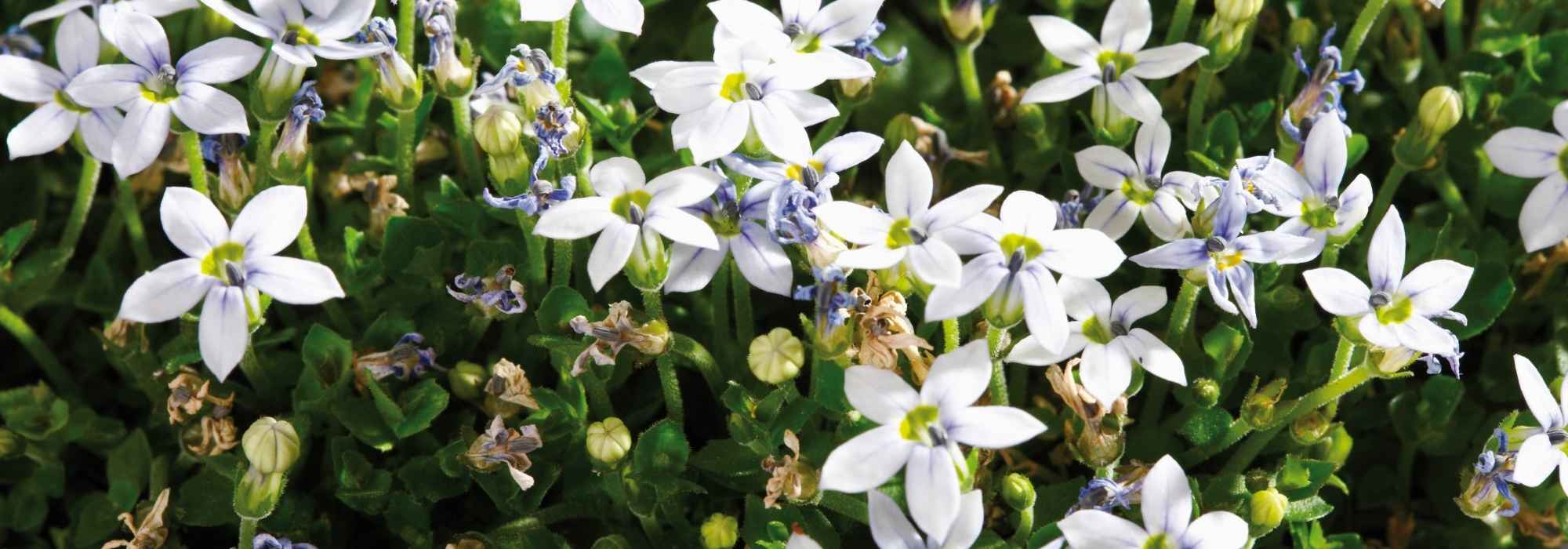
Pratia: planting, cultivation, maintenance
Contents
The Pratia in a nutshell
- This is an attractive semi-evergreen ground cover, sometimes considered invasive
- It makes a great alternative to grass, tolerating light foot traffic without issue, unless it’s too intense
- Its bright green foliage is covered from spring to summer with small star-shaped white or blue flowers
- Tolerant, it thrives in all types of soil and exposures
- Hardy and low-maintenance, it eliminates the need for weeding or adorns stepping stones
The word from our expert
Pratia is a charming semi-evergreen ground cover that makes an excellent alternative to lawn in lightly trodden and not too dry areas. The tiny, intense green foliage of this hardy and vigorous perennial is adorned in summer with pretty star-shaped flowers, blue in the variety ‘County Park‘, pure white in its form ‘Alba’.
With a fearless, almost invasive nature, it forms a flowering carpet no more than 5 cm high, quickly colonising any available space. Pratia pedunculata and Pratia angulata easily slip between stepping stones or replace lawn in less frequented areas of the garden, but in humus-bearing, well-drained, and moist soil.
To stay beautiful and retain its foliage in summer, Pratia simply requires watering adjusted to your region.
Maintenance-free, it doesn’t need mowing and thrives equally well in sun or partial shade.
Discover this ground-hugging plant that can effectively replace lawn!
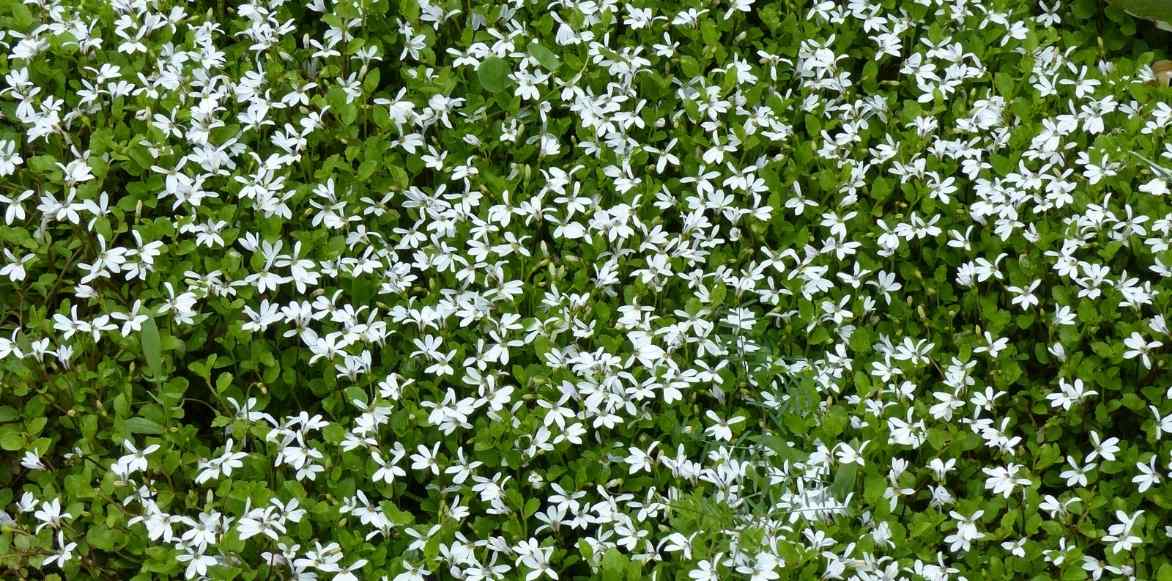
Pratia pedunculata ‘Alba’
Description and botany
Botanical data
- Latin name Pratia
- Family Campanulaceae
- Common name Pratia
- Flowering May to August
- Height 5 cm
- Exposure Sun, partial shade
- Soil type Rich and light
- Hardiness -10-15°C
The Pratia is a perennial ground cover plant from the Campanulaceae family. The genus includes around twenty species native to Australia and New Zealand, including Pratia pedunculata or Isotoma fluviatilis and its cultivars, which are the most common in our gardens. You may also encounter Pratia angulata, with zygomorphic flowers, meaning they display a particular symmetry.
It features a very carpet-like growth habit, with long, ramified stems that root into the soil at each node and an underground root network extending about ten centimetres deep and spreading quickly sideways. This allows the plant to colonise the soil surface, theoretically without limits. The height of the carpet will not exceed 3 to 5 cm.
This lovely plant can become invasive, but it forms a beautiful flowering cushion that can replace grass in less-trodden areas of the garden.
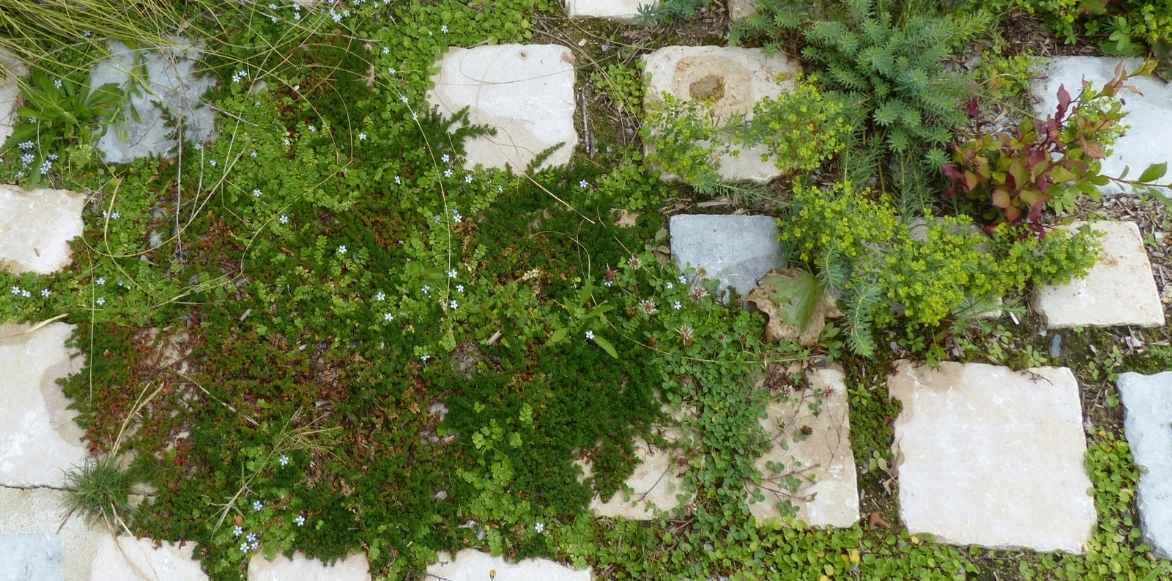
Pratia pedunculata and Frankenia laevis
Its short, running stems bear small leaves, 5 to 10 mm long, more or less evergreen depending on the severity of winter. They are alternate, bright green to light green in colour, ovate in shape, delicately dentate at the edges, resembling water droplets. In cases of pronounced summer drought, the foliage dries out and becomes deciduous, but the plant eventually reappears when the rains return.
The abundant flowering occurs in spring, usually in May-June, and often reappears in July until autumn, sometimes until frost, if the soil remains moist. Tiny star-shaped, solitary, and erect flowers dot this leafy carpet. They are composed of 5 petals, most often pure white, white veined with purple, or sometimes blue, like the very bright Pratia pedunculata ‘County Park’. Borne on long peduncles, they stand out well above the foliage. They give way to small, round or ovoid fruits in a plum colour.
Main species and varieties

Pratia angulata
- Flowering time June, July
- Height at maturity 5 cm
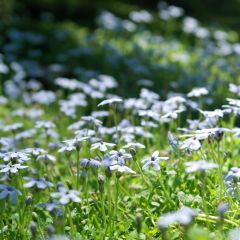
Pratia pedunculata
- Flowering time June to September
- Height at maturity 5 cm
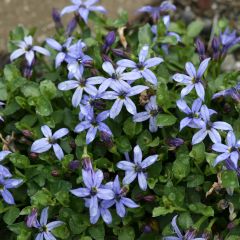
Pratia pedunculata County Park
- Flowering time June to September
- Height at maturity 5 cm

Pratia pedunculata Alba
- Flowering time June to September
- Height at maturity 5 cm
Discover other Pratia
View all →Available in 2 sizes
Available in 2 sizes
Available in 1 sizes
Available in 1 sizes
Planting Pratia
Where to Plant It?
Often used as an alternative to lawn in moderately trampled and small areas of the garden, as it requires regular watering (depending on the region), Pratia works wonders in our continental gardens. Easy to grow, it will thrive in lightly shaded areas, or even in full shade in regions south of the Loire, as it dislikes scorching sun during the hottest hours of summer.
To stay beautiful and retain its foliage, it requires regular watering depending on the region and rainfall, although it can withstand temporary drought. Its above-ground parts disappear in case of severe drought or lack of water in summer. It prefers fresh to moist, ordinary, well-drained, and humus-bearing soils. It dislikes stagnant moisture in winter.
This is a vigorous ground cover whose foliage persists in mild climates but will be scorched by frost below -10°C, while the root system can withstand frosts of around -15°C.
Very low-growing, it makes an excellent alternative to lawn in slightly neglected and less frequented areas of the garden, where it will prevent weeds from taking hold. It will not tolerate heavy foot traffic.
However, ensure it has enough space, as it does not tolerate competition and tends to quickly smother other plants.
It flowers in the gaps between paving stones and stepping stones, softens the edge of a path, or forms a beautiful ground cover in woodland areas or hard-to-mow spots. Given its expansive, even invasive nature, it’s best planted away from perennial beds. It can also be planted in a Japanese or Zen garden to create minimalist scenes. It also works well in pots or troughs.
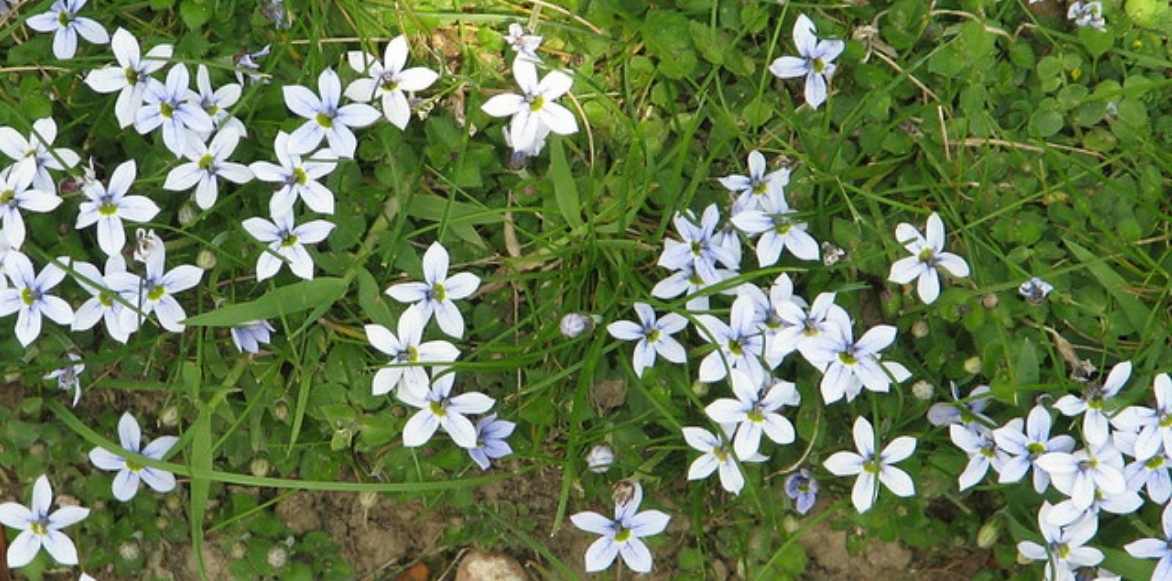
Pratia pedunculata (© Peganum)
When to Plant It?
Plant Pratia in autumn from September to November or in spring from March to May, avoiding frost and drought periods.
How to Plant It?
In the ground
Plan for at least 7 buckets per square metre, spaced about 30 cm apart to allow the stems to spread and ensure good coverage. If your soil is heavy, very clayey, and too compact, incorporate river sand and compost. The soil should be well loosened to depth.
- Dig a hole 2 to 3 times wider than the root ball
- Create a drainage layer at the bottom of the hole by spreading gravel to a depth of 10 cm
- Place the plant in the centre
- Fill in with garden soil enriched with a little compost
- Water thoroughly
In pots
Choose a wide, shallow container with drainage holes, from which it will spill attractively. Ensure the substrate remains moist, especially in summer.
- Spread a good layer of drainage material (gravel or clay pebbles) at the bottom of the pot
- Plant in a well-draining mix of garden soil and compost with coarse sand
- Water regularly
Maintenance and Care
Pratia requires almost no maintenance. Water regularly during the first year after planting to help it establish strong roots. It does not need mowing and only requires consistent watering during drought and extreme heat. Adjust the watering frequency according to your climate: in the South of France, one to two waterings per week are often necessary to keep the foliage healthy in summer.
Weed regularly around the base until it fully covers the soil.
In winter, in harsh regions, we recommend mulching the stump with a thick layer of dried leaves or straw.
If you wish to control its spread, manually remove any excess rooted stems.
In pots, the soil dries out faster than in the ground, so water regularly throughout the summer to maintain a moist to damp substrate and encourage the development of long stems.
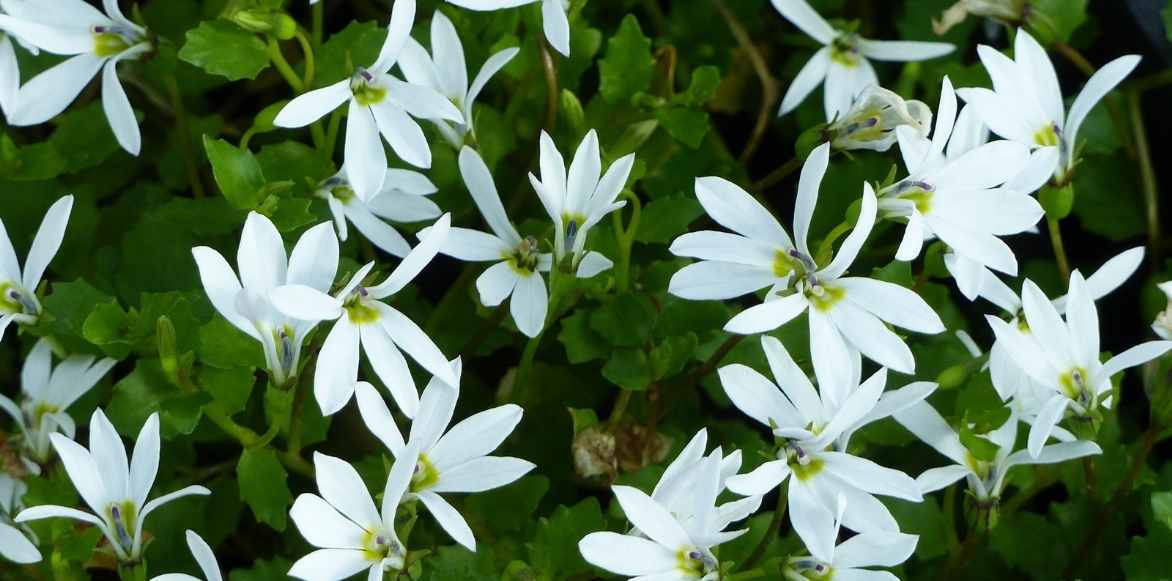
Pratia angulata
Multiplication
Propagating Pratia is simply done by taking rooted stems.
In spring or autumn, pull up the stolons and replant them in moist, sandy soil. Ensure regular watering to encourage establishment.
Pair
Pratia is ideal for filling gaps in paving or hard-to-reach corners. Particularly expansive once acclimatised to the garden, it’s best to avoid planting it in a rockery or perennial bed. So, although it’s often used alone, pairing it is still possible. As it’s highly adaptable, it thrives equally well in partial shade or full sun.
In shade, you might consider pairing it in minimalist compositions, with horsetails, ferns, hostas, a carpet of Epimedium, and with helxine, a mossy-looking ground cover often used in Japanese-style gardens.

Pratia, Helxine, horsetail, and hostas
In sun, for a wilder, more romantic style, plant Pratia near a natural bed composed of grasses, scabious, yarrow, sage, coneflowers, and a few clumps of Erigeron karvinskianus with steely blue hues. It can also be used to carpet the base of softly coloured roses like the climber ‘Iceberg’.
In pots, it will serve as a frame to highlight the fresh hues of spring bulbs like tulips.

Pratia angulata, climbing rose ‘Iceberg’, Erigeron karvinskianus, and scabious
→ Discover more ideas for pairing Pratia in Virginie’s advice sheet!
Useful resources
- What is a good ground cover as an alternative to lawn?
- Subscribe!
- Contents

































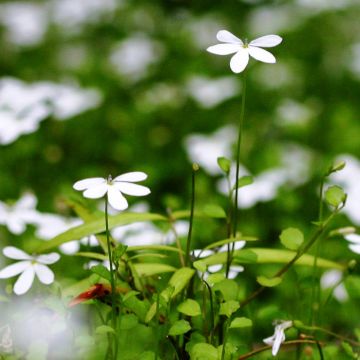
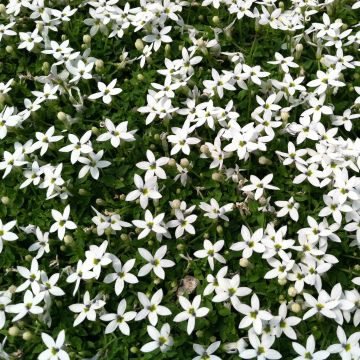
Comments